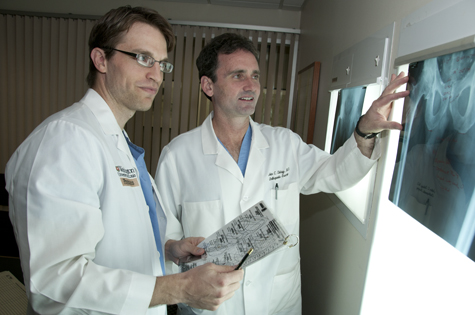
When John C. Clohisy, MD, was growing up, he didn’t have to look very far to come into contact with medicine. His father, Warren, was a general surgeon, and his mother, Marguerite, was a nurse anesthetist. More than half of their 10 children followed them into one branch of medicine or another.
Clohisy, the Daniel C. and Betty B. Viehmann Distinguished Professor in Orthopaedic Surgery, and his older brother, Denis, both chose orthopedics. Three of his sisters are nurses, and a fourth went into occupational therapy. But even that family pedigree didn’t make a career in medicine a “slam dunk” for him.
“I considered becoming a doctor, but I also was interested in teaching, and I enjoyed research, too,” he says. “I didn’t fully commit to medicine until the end of college. That’s when I began seriously thinking about what I wanted from a profession, and I decided medicine had the potential both to challenge me intellectually and allow me to help other people in a very tangible way.”
Born in Evanston, Ill., Clohisy attended his “hometown” college, earning both a bachelor’s degree and then a medical degree from Northwestern University. During medical school, he made the decision to pursue orthopedics.
“It attracted me because, first of all, I enjoyed the dynamics of a surgical practice,” he says. “Meeting and evaluating the patient, the surgical decision-making process, preoperative surgical planning and the operating room environment, collectively, appealed to me.
“I was intrigued by the concept of using my hands and working to develop the technical skills required of a competent surgeon. Early in my training, I also was exposed to the tangible and very positive impact that orthopedic procedures could have on patients, in terms of relieving their pain, enhancing their activity levels and improving their quality of life.”
Although helping patients feel better isn’t unique to orthopedics, he says the vast majority of his team’s patients improve remarkably following an operation, and it’s gratifying for him and the entire patient care team to be able to play a role in changing their lives.
Clohisy says the “wonders” of contemporary orthopedics are the result of decades of clinical and scientific investigation by the international orthopaedic community.
“The field’s accomplishments to date serve as motivation to continue our clinical, education and research missions focused on improving the lives of patients with musculoskeletal problems,” he says.
He also chose orthopedics because of the diversity that the specialty provided. He not only could work in the operating room, but he also had the opportunity to spend time in the clinic, getting to know patients and being able to follow them through their recovery and rehabilitation.
Orthopaedic surgeons also serve a diverse patient population from childhood through adulthood, patients with a wide spectrum of clinical problems ranging from acute trauma to chronic joint disease. After graduating from medical school, he made his way to St. Louis for internship, research fellowship and residency at Saint Louis University School of Medicine.
“The faculty at Saint Louis University, as a whole, were excellent,” he says. “They were very supportive and motivated me to be my best. The training environment helped me develop a learning style that has served me extremely well over the past 20 years.”
By 1995, he had become chief resident. Then came one more fellowship, this time in the Hip & Implant Unit at Massachusetts General Hospital in Boston, before eventually returning to St. Louis to join the faculty in the Department of Orthopaedic Surgery at the School of Medicine.
Not a recipe-book approach
A joint replacement and revision specialist, Clohisy has become a national leader in performing hip preservation surgery in younger patients with hip dysplasia or impingement.
“A total hip replacement can function well for 20 years or so, but if we’re dealing with a patient in his or her late teens or early 20s, then that replacement is likely to fail while that individual is in their 40s, and they’d be facing additional hip replacement surgery,” he says. “That’s not ideal, and therefore, over the past decade, we have focused on early diagnosis and ‘joint preservation surgery’ for patients with pre-arthritic and early arthritic hip disease.”
Clohisy says two major problems tend to result in young people being referred to him: hip dysplasia and hip impingement. In the “ball and socket” of the human hip, those with dysplasia tend to have a shallow socket, making the ball (the femoral head) unstable. These patients often have activity-related hip pain and develop arthritis over time.
In those with hip impingement, either the socket is too deep or the femoral head is misshapen, so again, the bones don’t fit together properly. Patients have activity-related hip pain and eventual joint degeneration due to the repetitive “impingement” around the periphery of the joint.
In the operating room, Clohisy may reposition the natural hip socket to stabilize the joint, or, in cases of impingement, reshape the femoral head so that it fits into the hip socket without impingement. He also repairs associated problems in the joint like cartilage tears and early arthritis. But he says there isn’t really a standard method for many of these operations.
“We have a preoperative plan and reconstructive goals, but hip preservation surgery is definitely a more dynamic type of surgery rather than ‘recipe-book’ type procedures,” Clohisy says. “Our technique often is modified during the course of the operation, and the amount of bone resection or repositioning of the femur or the hip socket can change significantly. That’s a very challenging and enjoyable part of the job.”
Academic interests
During his training, Clohisy decided not only on orthopedics, and later hip and knee reconstruction as a specialty, but he also decided he wanted to find a niche in academic medicine because he loved teaching and enjoyed research.
Apparently, he’s good at it. He’s a past recipient of the Department of Orthopaedics’ Palma Chironis Award (for Excellence in Teaching). He’s also a two-time recipient of the department’s Jerome J. Gilden Distinguished Physician Award (Excellence in Patient Care). His patients range from teenagers with hip dysplasia to older adults who need a total hip replacement.
“John delivers incredibly compassionate care,” says his colleague and friend Rick W. Wright, MD, the Dr. Asa C. and Mrs. Dorothy W. Jones Professor in Orthopaedic Surgery. “The beauty of John Clohisy’s management of hip disease is that it is all-encompassing, from ‘cradle to grave.’ With hip replacement, minimally invasive surgery and hip preservation procedures for younger patients, he is able to tailor the care he delivers to an individual patient’s needs.”
Gone fishing
Although modern techniques for hip replacement can take less than an hour, complicated revision and reconstruction surgeries can take four to six times that long, so when Clohisy gets away from the operating room and the clinic, he likes to get pretty far away. With four boys between the ages of 9 and 21, there’s still a lot of activity at home, but Clohisy says when time permits, he and his wife, Mary, enjoy taking them to quiet, beautiful places to enjoy outdoor activities, especially fishing.

Courtesy photo
The Clohisy family (from left): Son Tim, John C. Clohisy, MD, wife Mary, son Patrick, son Matthew, and son John.
“A lot of our vacations are more outdoor-type trips,” he says. “We like the beach, lakes, rivers and mountains, so we can have fun at just about any destination.”
The boys cover the gamut from grade school through college, and they haven’t yet figured out their own career paths. Like his own father, Clohisy says he isn’t pushing. Rather, like a fisherman, he says he’s patiently waiting to see how things evolve.
“We just want to support their decisions and try to provide guidance when needed,” he says.
Fast facts about John C. Clohisy
Born: May 10, 1962, in Evanston, Ill.
University position: Daniel C. and Betty B. Viehmann Distinguished Professor, Department of Orthopaedic Surgery
Education: BA, 1985, Northwestern University; MD, 1989, Northwestern University Medical School; general/orthopaedic surgery internship, 1989-90, resident research fellowship, 1990-92, orthopaedic surgery residency, 1992-96, Saint Louis University Hospital; adult reconstructive surgery fellow, Hip & Implant Unit, 1996-97, Massachusetts General Hospital, Harvard Medical School
Family: Wife, Mary; sons John, 21, Timothy, 19, Matthew, 16, and Patrick, 9